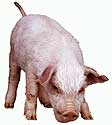
FRIDAY, Oct. 12 (HealthDay News) —
Living near livestock may raise your risk of picking up a so-called “superbug,” methicillin-resistant Staphylococcus aureus(MRSA), according to a new study.
“In recent years [livestock-associated MRSA] is found with increasing frequency in community-dwelling individuals with no known contact with livestock,” said study co-author Dr. Jan Kluytmans, a professor of medical microbiology and infection control at VU University Medical Center Amsterdam and Amphia Hospital Breda, the Netherlands. “It is important to determine the routes of transmission outside of the farms, since this may have important consequences for public health.”
When livestock-associated MRSA was first discovered in the Netherlands in 2003, it was almost exclusively found in persons with direct contact to livestock.
The researchers concluded that regional density of livestock is a key risk factor for nasal carriage of livestock-associated MRSA both for people who had direct contact with livestock and those who didn’t. They noted nasal carriage of MRSA doesn’t mean people are infected with the bacteria, but it is linked to greater risk of infection later on.
In conducting the study, researchers from the Johns Hopkins Bloomberg School of Public Health, the Dutch Institute for Public Health and the Environment and VU University Medical Center in Amsterdam examined data on livestock-associated MRSA carriage in the Netherlands, as well as the country’s statistics on livestock and population densities to determine how regional risk factors affected people’s risk for MRSA.
The researchers also considered whether or not people had direct contact with animals and where they lived, and analyzed the geographic spacing of livestock-associated MRSA compared to other types of MRSA.
“We found that as the density of veal calves, pigs or cattle doubles in a specific area, the odds of carrying [livestock-associated MRSA] increases between 24 percent and 77 percent, depending on the animal,” study author Beth Feingold, a postdoctoral fellow in global change at the Johns Hopkins Zanvyl Krieger School of Arts and Sciences, said in a news release from Hopkins’ School of Public Health. “These results challenge us to understand how these exposures could be occurring.”
MRSA, a hard-to-treat type of staph bacteria, has become resistant to common antibiotics. In the past, MRSA was primarily associated with hospitals and
other health care facilities, but now most MRSA infections are acquired in the community outside of a health
care setting, according to the news release.
The findings could have significant implications for Americans since pig farming is a larger industry in the United States than the Netherlands, the study authors said.
“Future work should investigate the relationship between intensive livestock operations in the U.S. and exposures to drug-resistant microbes including MRSA,” concluded study co-author Ellen Silbergeld,
a professor with the Bloomberg School of Public Health’s department
of environmental health sciences.
The study is published in the November issue of Emerging Infectious Diseases.
Although the study found an association between living near livestock farms and contracting MRSA, it did not establish a cause-and-effect relationship.
More information
The U.S. Centers for Disease Control and Prevention provides more information on MRSA.

